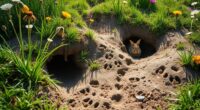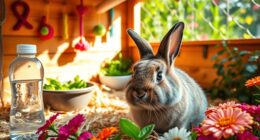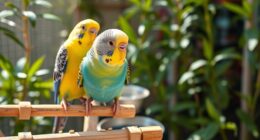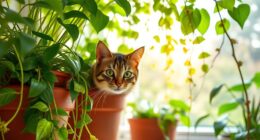Animals heal themselves in the wild by instinctively seeking out natural remedies from their environment. For instance, chimpanzees eat specific leaves for their antibiotic properties, while elephants chew on bark for arthritis relief. Dogs often consume grass to ease gastrointestinal issues, and birds engage in "anting" to combat parasites. These behaviors show a remarkable understanding of local flora and how it can aid health. There's much more fascinating information about animal self-medication waiting for you.
Key Takeaways
- Animals utilize local plants with medicinal properties, such as orangutans using Akar Kuning for wound healing and elephants consuming fever tree bark for arthritis relief.
- Chimpanzees and other primates exhibit anting behavior, using ants and millipedes for parasite control and infection treatment.
- Dogs instinctively consume grass and herbs like peppermint and ginger for gastrointestinal relief and overall health support.
- Pregnant elephants and reindeer seek specific plants to aid in labor and reproductive health, showcasing their environmental awareness.
- Animals' self-medication behaviors reflect their understanding of local flora's health benefits, emphasizing the importance of biodiversity in ecosystems.
A Plaster of Plants

When you observe animals in the wild, you might be surprised to see them using plants as natural bandages for their wounds. Animals like orangutans utilize Akar Kuning to create effective plasters, demonstrating their instinct for healing.
Chimpanzees in Gabon take it a step further by applying millipedes to their skin, using their insect-repellent properties for protection against parasites.
Chimpanzees in Gabon cleverly use millipedes on their skin for their insect-repellent benefits, showcasing their natural healing instincts.
African elephants chew fever tree bark to alleviate arthritis pain, showcasing their ability to seek out medicinal plants.
Additionally, various bird species engage in "anting," using formic acid from ants to clean their feathers.
Even pregnant lemurs strategically consume bark and leaves from fig and tamarind trees to boost milk production and reduce parasites, illustrating the impressive resourcefulness of animals using nature for healing.
Magic of Zoopharmacognosy

The remarkable phenomenon of zoopharmacognosy reveals the innate wisdom animals possess in using their surroundings for healing.
You might be surprised to learn that numerous species, from chimpanzees to elephants, engage in animal self-medication. For instance, chimpanzees munch on leaves with antibiotic properties to combat infections, while African elephants chew on fever tree bark to ease arthritis pain.
What's even more fascinating is that these animals often select non-dietary plants with low nutritional value when they're unwell, showcasing their conscious choice to harness medicinal resources.
Additionally, over 200 bird species practice "anting," using ants to coat their feathers with formic acid, helping to eliminate parasites.
This magic of zoopharmacognosy highlights the intelligence and adaptability inherent in the animal kingdom.
Healing Power of Insects

Insects wield remarkable healing powers, often serving as natural remedies for various animals. You'll find that animals use these tiny creatures in fascinating ways to promote health. For instance, chimpanzees consume ants and millipedes to repel parasites and treat wounds. Similarly, wood ants utilize tree resin to combat infections. Birds engage in "anting," where they cover themselves in formic acid to maintain feather health. This self-medication, where animals apply environmental knowledge for healing themselves is called zoopharmacognosy, showcases their sophistication.
| Insect Type | Healing Benefit |
|---|---|
| Ants | Antimicrobial properties |
| Millipedes | Parasite repellent |
| Wood Ants | Infection control |
| Chimpanzees | Wound treatment |
| Birds (Anting) | Feather health maintenance |
Learning From Bears
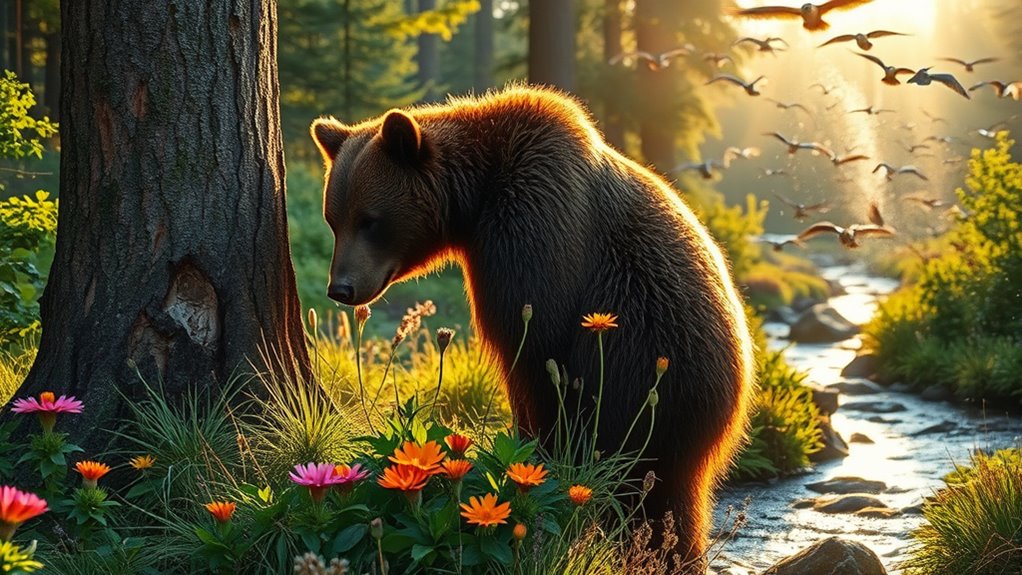
Have you ever noticed how bears instinctively seek out specific plants to heal themselves?
By observing their use of natural remedies, you can see how traditional knowledge has shaped both animal behavior and human medicine.
Learning from bears not only highlights their unique self-care practices but also inspires new approaches in our own health and recovery.
Natural Remedies Utilized
While exploring the natural world, you might be surprised to discover how much animals like American black bears rely on instinctive remedies for healing.
These bears utilize natural remedies such as osha root to alleviate arthritis pain, showcasing their remarkable instinctive knowledge. After hibernation, they often consume salicylate-rich plants, which help relieve joint pain, highlighting their understanding of recovery through nature.
Observing these behaviors not only reveals how animals in the wild heal themselves but also inspires human medicine. The medicinal practices of bears, like chewing specific roots, have influenced the development of pharmaceuticals, illustrating a deep connection between animal behavior and potential human treatments. Furthermore, understanding sustainable practices in nature can lead to more effective and eco-friendly medicinal approaches in human healthcare.
Traditional Knowledge Influence
As you explore the traditional knowledge surrounding animal healing, you'll find that the practices of Indigenous peoples often mirror the instinctive behaviors of American black bears.
For centuries, these communities have observed bears consuming osha root to alleviate arthritis pain, integrating this wisdom into their own medicinal practices. This connection highlights how animals, like bears, utilize salicylate-rich plants post-hibernation, inspiring human medications such as aspirin.
Shamans across cultures revere bears for their healing insights, showcasing a profound understanding of local flora's medicinal properties. Observing bear health behaviors not only enriches traditional knowledge but also emphasizes the interconnectedness of animal and human health, reminding us of the invaluable lessons nature offers in self-healing. Additionally, engaging with positive thinking strategies can enhance our approach to health and well-being, drawing parallels between nature's wisdom and personal development practices.
How Dogs Use Natural Laxatives
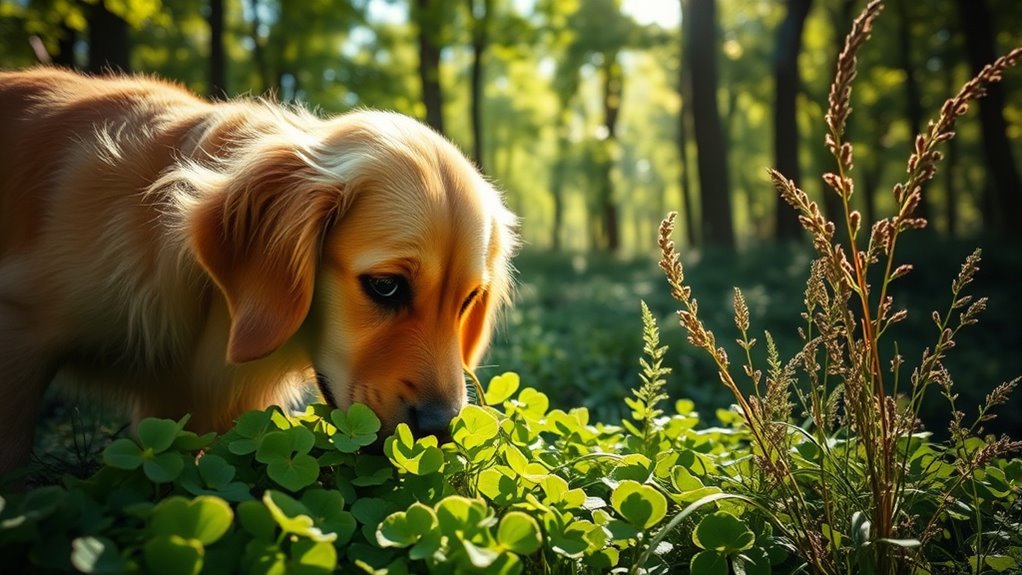
You might notice your dog munching on grass when their stomach isn't feeling right.
This natural behavior, rooted in their wild ancestry, serves as a way for them to clear irritants from their digestive system.
Understanding this instinct can help you appreciate how dogs use available resources for self-care.
Grass Consumption Behavior
About 25% of dogs regularly munch on grass, and this peculiar behavior often serves a practical purpose.
Dogs engage in grass consumption as a form of self-medication, a practice known as zoopharmacognosy. When experiencing gastrointestinal discomfort, they instinctively seek out grass, which may act as a natural laxative or help induce vomiting if needed.
This behavior likely traces back to their wolf ancestors, who used similar methods to purge their systems of parasites or indigestible materials.
Curiously, the grass dogs prefer is typically non-toxic and can even provide beneficial nutrients. While many dogs enjoy the taste or texture, it's clear that this grass-eating habit plays a role in their overall health and well-being. Additionally, the importance of regular veterinary check-ups can help ensure that any underlying health issues are addressed promptly, complementing their natural instincts.
Natural Digestive Remedies
When dogs experience digestive discomfort, they often turn to natural remedies like grass and certain herbs to find relief.
This instinctual behavior harks back to their wild ancestors, showcasing their ability to self-medicate through zoopharmacognosy.
Here are some natural digestive aids your dog might seek out:
- Grass: Helps induce vomiting and expel toxins.
- Peppermint: Alleviates gas and soothes upset stomachs.
- Ginger: Reduces nausea and promotes digestion.
- Dandelion: Supports liver health and aids digestion.
A Nice Bird Bath in Formic Acid

While many people think of bird baths as simple water sources, birds have a unique way of enhancing their hygiene with a natural twist: formic acid.
Over 200 bird species, like blue jays and robins, engage in a fascinating behavior known as "anting," where they cover themselves with formic acid from anthills.
This process not only promotes feather health but also acts as a natural antimicrobial agent, helping to kill parasites and harmful microorganisms.
Particularly during molting, when birds are most vulnerable, anting plays a significant role in their overall well-being.
This intelligent use of their environment highlights the remarkable ways animals heal themselves, showcasing nature's remedies for maintaining health and hygiene in avian life.
Naturally Inducing Birth

Animals have an incredible ability to instinctively seek out natural remedies, especially during critical life events like childbirth. They often engage in behaviors that show a deep understanding of how to naturally induce birth and keep themselves healthy.
Here are some fascinating examples:
- Pregnant elephants eat leaves from boraginaceae trees to help induce labor.
- Reindeer in Finland consume Amanita muscaria mushrooms, which may influence their birthing process.
- Wild chimpanzees use specific plants for reproductive health, though details are less documented.
- Female elephants change their travel patterns to find beneficial plants before giving birth.
These behaviors highlight the remarkable connections between animal health, their environment, and the use of local flora to facilitate reproductive processes.
Frequently Asked Questions
How Do Animal Wounds Heal in the Wild?
When it comes to how animal wounds heal in the wild, you'll find that animals often rely on their instincts and natural remedies.
They use specific plants or substances around them to promote healing. For instance, some animals lick their wounds to keep them clean, while others might seek out certain herbs or roots for their anti-inflammatory properties.
This self-medication helps them manage pain, prevent infections, and speed up the healing process effectively.
Do Animals' Broken Bones Heal in the Wild?
Yes, animals' broken bones can heal in the wild! You might find it fascinating that many species have evolved incredible healing abilities.
When a fracture occurs, they often limit their movement to allow the bone to mend. Some even seek out specific plants with healing properties.
However, environmental factors and their ability to avoid predators during recovery play an essential role in their healing success.
Nature truly has a remarkable way of helping them recover!
How Do Animals Protect Themselves in the Wild?
In the wild, animals use various strategies to protect themselves. You might notice how skunks spray a foul odor to deter predators, while porcupines display their sharp quills.
Some creatures, like the octopus, blend into their surroundings for camouflage. Elephants use their size to intimidate threats, and social insects like ants swarm together to defend their colonies.
Reptiles, such as lizards, can even shed their tails to escape while distracting their pursuer.
How Do Animals Survive Infections in the Wild?
In the wild, animals face fierce foes, fighting infections with instinctive intelligence.
You'll see species seeking specific plants to stave off sickness, showcasing their survival skills. For instance, some birds use ants to apply natural antiseptics, while elephants munch on medicinal bark to manage pain.
These remarkable behaviors reflect a deep understanding of their environment, proving that nature equips them with the tools they need to thrive, even amidst the threat of infection.
Conclusion
In the wild, animals are nature's ultimate healers, wielding the power of plants and instincts like ancient wizards. From bears munching on berries to dogs hunting for natural laxatives, they've mastered the art of self-care in ways we can only dream of. Imagine if we could tap into that wisdom, transforming our ailments with a sprinkle of formic acid or a dance with wild herbs! Nature's pharmacy is open, and it's time we take a page from their book!

